![]()
![]()
![]()
Use LEFT and RIGHT arrow keys to navigate between flashcards;
Use UP and DOWN arrow keys to flip the card;
H to show hint;
A reads text to speech;
140 Cards in this Set
- Front
- Back
|
Weeds A) Biology i.) Lifecycles |
|
|
|
Rosette: |
A circular cluster of leaves that forms after the early seedling stage but before a flower stalk is sent up |
|
|
Bud Stage |
Earliest stage of reproductive growth. Stage just before bloom when flower parts are forming but flower has not yet opened |
|
|
Bloom |
Flowers have opened. |
|
|
Maturity |
Seed has formed. Plant is relatively inactive |
|
|
Spike stage |
Very early emergence stage |
|
|
Tillering stage |
Forming of erect shoots or tillers from the crown of a grass |
|
|
Jointing stage |
Begins after tillering |
|
|
Boot Stage |
When the infloresence expands the upper leaf sheath. Head is swollen but not yet visible |
|
|
Flag Stage |
Early postemergence stage of onion seedlings between the crook stage and the emergence of the first true leaf. |
|
|
Annuals |
Plants with a one-year life cycle |
|
|
Summer annuals |
-Crabgrass, foxtail, pigweed, lambsquarters, Russian thistle, nightshades, barnyardgrass |
|
|
Winter annuals |
-Cheat, henbit, fiddleneck, chickweed |
|
|
Biennials
|
-Mullein, bull thistle, tansy ragwort, wild carrot. |
|
|
Perennials |
|
|
|
Simple perennials |
-Dandelions, Plantain, curly dock, false dandelion |
|
|
Bulbous perennials |
-Wild garlic |
|
|
Creeping perennials
|
-Johnsongrass, field bindweed, Canada thistle, Russian knapweed, yellow nutsedge, leafy spurge |
|
|
Grasses |
Have only one leaf as they emerge from the seed. Narrow and upright. Parallel veins. |
|
|
Sedges |
Triangular stems and three rows of leaves. |
|
|
Broadleaves |
Two leaves as they emerge from th eseed. Usually have a taproot and a relatively coarse root system. |
|
|
Postemergence Herbicide Groups
|
a) Those that move through the plant in the food stream (phenoxys, dicamba, glyphosate, amitrole). b) Contact herbicides, (paraquat, diquat and bromoxynil). |
|
|
Weed Susceptibility
|
2. Biennials are best controlled when they are in the seedling or rosette stage. 3. Perennials best at seedling, otherwise at the early to late-bud stage. |
|
|
Growth-regulator herbicides |
Small grains more susceptible when applied during periods of rapid floral development. Wait until sheath is 2", fully tillered.
|
|
|
Weed Identification |
|
|

|
Field Bindweed (Convolvulus arvensis)
|
|

|
Canada Thistle (Cirsium arvense)
|
|

|
Field Horsetail: Herbaceous perennial, rhizomatus
|
|
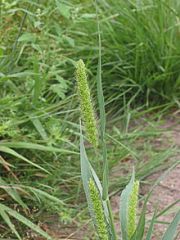
|
Green Foxtail: Grass, found in disturbed areas
|
|
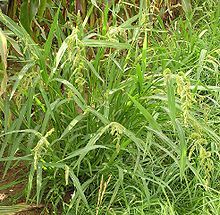
|
Barnyardgrass (Echinochloa crus-galli):
|
|
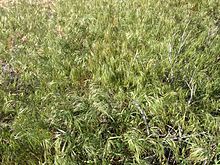
|
Downy Brome (Bromus tectorum): Annual bunchgrass (Summer). Highly adaptable. Likes coarse soils. Seeds disperse by wind or rodents.
|
|
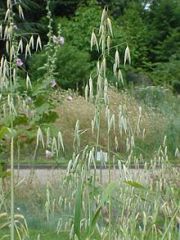
|
Wild Oat (Avena fatua). Annual. Similar to cultivated oats but yield little grain. Slender tall grasses.
|
|
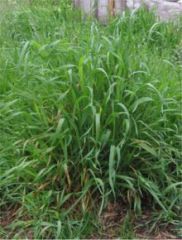
|
Quackgrass (Elymus repens): Perennial grass. Bunches with lots of rhizomes. Moves quickly.
|
|

|
Yellow nutsedge (Cyperus esculentus): Sedge. Identifiable by the "nuts" which are bulbs on its roots. Moves easily by cultivation. Likes coarse soils.
|
|

|
Lambsquarters (Chenopodium album):
|
|

|
Pigweed (Amaranthus): Known for tall, red flowers. Certain species are glyphosate resistant. Can cause crop loss in beets, soybeans
|
|

|
Hoary cress (whitetop) (Cardaria draba): perennial herb. Reproduces by seeds and creeping roots.
|
|
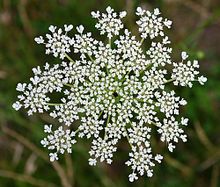
|
Wild carrot (Queen Anne's Lace): Perennial, makes woody carrot-like tuber. Can resemble poison hemlock. Roots can be an abortificant. Leaves can cause dermal irritation.
|
|
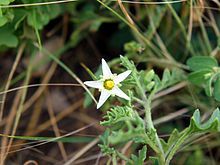
|
Hairy Nightshade: Summer annual, makes large clumps. Common in WV nurseries.
|
|

|
Jointed Goatgrass (Aegilop cylindrical): Part of the tritacae family. Genetically almost identical to winter wheat, hence, very difficult to kill off without harming the winter wheat.
|
|
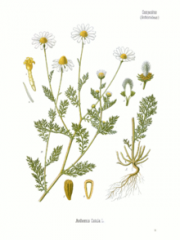
|
Mayweed chamomile (Anthemis cotula): Similar to pineapple weed, but has hairs. Annual. Stinky. Layne vineyard |
|

|
Russian knapweed (Centaurea repens): Bushy rhizopatameus perennial.
|
|
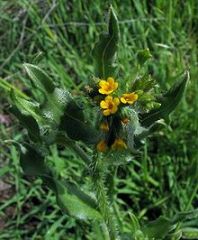
|
Coast fiddleneck (Ansinckia intermidea):
|
|

|
Russian thistle: Succulent shrub. Salt/alkali resistant.
|
|
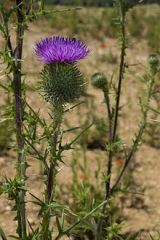
|
Bull thistle (Cirsium vulgare): Large thistle plant with prickly leaves and large bulb. Biennial.
|
|
|
What is a weed?
|
A plant growing where some human doesn't want it.
|
|
|
Five ways that weeds can be beneficial
|
2. Recycling nutrients 3. Gene pool 4. Esthetics |
|
|
Five ways that weeds can be detrimental |
2. Contaminating the product at harvest 3. Harboring pest insects 4. Releasing toxins in the soil. 5. Hindering fish growth 6. Promoting mosquito production 7. Clogging irrigation ditches 8. Poisoning grazing animals 9. Physical Damage 10. Off flavor in milk and meat 11. Hinder right of way. |
|
|
Summer Annual vs. Winter Annual
|
1. Crabgrass 2. Foxtail 3. Lambsquarters 4. Russian Thistle Winter Annual: Seeds germinate in the Fall 1. Cheat 2. Henbit 3. Fiddleneck 4. Chickweed |
|
|
Biennial vs. Winter Annual
|
Winter annual: Germinates in fall, seed head forms before following fall. |
|
|
How do simple perennials spread?
|
They send down a tap root and form crown buds. Normally reproduce by seeds, however root pieces can produce new plants.
|
|
|
Chapter 2 Adjuvants for Herbicide Sprays |
|
|
|
Adjuvant:
|
A substance added to a pesticide mixture to help the main ingredient do a better job
|
|
|
Surfactants
|
A type of adjuvant. Double ended. One end is lipophilic, the other is hydrophilic, this helps oils dissolve in water. |
|
|
Anionic, cationic, non-ionic
|
Cationic: Ionizes to form a positively charged hydrophilic portion. Nonionic: Most commonly used. Non toxic, easy to use. Not affected by hard water. |
|
|
Does it help to add .1% of wetting agent?
|
Yes., Although it won't spread out more, it can increase the uptake and effectiveness. |
|
|
When may adding a wetting agent not be advisable?
|
2) They cost money, so if the weed can be wet without the agent, it would be wasteful. |
|
|
Phytobland
|
Non-phytotoxic
|
|
|
USR
|
Unsulfonatable Residue. Means the portion of the material that does not bind to the target weed. The % of USR helps to determine the selectivity of the material. High % USR is more phytobland, allowing the herbicide to penetrate the leaves of plants. Low USR's are non-selective and more phytotoxic. Use a phytotoxic selective oil in Carrots. |
|
|
How do drift retardants reduce drift? |
They reduce the number of "fines" which are the compounds that drift.
|
|
|
List 8 types of adjuvants |
1. Anionic Surfactants 2. Cationic Surfactants 3. Non-ionic surfactants 4. Phytotoxic-non selective oils 5. Phytotoxic-selective oils 6. Phytobland oil-water emulsions. 7. Drift retardants 8. Buffering agents 9. Foaming agents. 10. Anti-foaming agents. 11. Odor inhibitors. 12. Stenching agents. 13. Emetics |
|
|
Buffering Agent
|
Adjusts pH to get it in range of the herbicide activity range. |
|
|
Chapter 3 Herbicide Formulations |
|
|
|
Formulating
|
Preparing a product for practical use
|
|
|
Spray formulations
|
1. Soluble Concentrate (Active ingredient is dissolved readily in either water or oil). 2. Emulsifiable Concentrate (Active ingredient is mixed with an emulsifier to help it dissolve in water) Need at least 1 lb/gal. 3. Wettable powders (Active ingredient is impregnated on clay or other inert material and ground finely) 4. Invert emulsion (Thick mayonnaise-like product) Reduce drift 5. Encapsulated formulations (Active ingredient is trapped in tiny capsules, which are then suspended in a liquid). |
|
|
Dry formulations
|
1. Granules. Active ingredient is impregnated on a clay and added as solid form to the ground. 2. Pellets: Larger than granules. Used for spot treatment 3. Dusts. Inert ingredient and toxicant. Herbicides are seldom applied as dusts |
|
|
Soluble concentrates
|
Disadvantage: May react with hard water, Active ingredient may not enter readily, May be readily leachable |
|
|
Emulsifiable Concentrates |
Advantage: Penetrates waxy foliage better, may be more effective against hard to kill weeds. Can be applied in hard water. Less likely to be washed off. Less abrasive. Suspend for longer time without agitation. Disadvantage: Less selective than other formulations. More easily absorbed by the skin. |
|
|
Wettable Powders |
Advantage: Cost is lower, can be added as water-soluble bag (easier/safer) Disadvantage: Needs constant agitation, less foliar activity, require water to be active in soil, abrasive on pumps, |
|
|
Flowable |
Advantage: Disadvantage: Need to mix well before measuring/adding. |
|
|
Dispersable granules or dry flowables |
Advantage: Low dust problem, can be measured by volume, Disadvantage: Sometimes incompatible with fertilizers, need to agitate |
|
|
Invert emulsions
|
Advantage: Reduce drift Disadvantage: Need special equipment to apply |
|
|
Encapsulated formuations
|
Disadvantage: Possible to wash off if doesn't adhere well |
|
|
Dispersable granule vs. dry flowable
|
They are the same. They consist of dry beads that disperse into a solution when added to water.
|
|
|
Once they have been added to water, how do wettable powders, dispersable granules, dry flowables and flowables differ?
|
They do not differ greatly once mixed with water. The main difference is in how well they mix with water.
|
|
|
What is the main reason for invert emulsions?
|
They control drift well |
|
|
Active ingredient and acid equivalent
|
Acid Equivalent: Concentrates of the herbicide that is active in its acid form. |
|
|
Order of adding
|
1. Wettable powders 2. Flowables 3. Water solubles 4. Surfacants 5. Emulsifiable concentrates |
|
|
Pre-mix check |
Add representative amounts of materials in a jar, mix well, then check to see if any layers/heat is formed. |
|
|
Chapter 4 Ten Important Herbicide Families |
|
|
|
A. Growth Regulator Types
|
Important Herbicides: 2,4-D diclorprop 2,4-DB 2,4,5-T mecoprop MCPB MCPA silvex |
|
|
Phenoxys |
GC's Volatility depends on the derivative of the acid Formulation dependent on the solubility Either soluble in organic solvents or formulated as EC's or water-soluble Short lived in the soil Acute toxicity moderate (300-1000 mg/kg) Mode of Action Absorbed and translocated Plug transport system Symptoms Distorted twisted growth, severe stunting 2,4-D Broadleaf control, perennials. not grasses 2,4-DP brush control MCPA safer on legumes, small grains.. More toxic to carrot family MCPP mostly used in turf. Safe on grass 2,4,5-T More toxic to brush, legumes Butyric compounds (2,4-DB). Not toxic to plants if enzyme is lacking. Legumes are tolerant. |
|
|
Dicamba |
Banvel Votality low to moderate Soil persistence longer, number of months Moderate to low toxicity Mode of Action Taken up by roots or leaves Translocated up or down and accumulated in areas of high metabolic activity Similar symptoms to 2,4-D Uses Different weed spectrum. Weak on mustards, borages. Broadleaf control in grass, turf, cereals |
|
|
Picloram
|
Low volatility Acqueous or granules Greater soil persistence than dicamba Low toxicity Taken up by foliage or roots Translocated up or down Disruption of growth similar to phenoxys cupping and stuntings Uses Selective control of broadleaves Non-cropland Spot treatments of perennial broadleaves Brush control *Most are restricted because of extreme activity on many broadleaves *High activity on non-target plants *Persistence in soil |
|
|
Triclopyr
|
Garlon (Crossbow or Turflon when mixed with 2,4-D) Similar to phenoxy herbicides Soil persistence longer than 2,4-D but shorter than picloran Moderate toxicity Mode of Action Similar to other growth regulators Uses Brush control in forests, pastures, non-crop areas More effective on blackberries than other herbicides Can control oxalis and lawn violets in turf |
|
|
Clopyralid
|
Stinger (Curtail when mixed with 2,4-D or Curtail M with MCPA) Low volatility Soil persistence similar to dicamba Low toxicity Taken up by foliage and roots Translocated up or down Symptoms Cupping and stunting of leaves, terminal growth ceases, root deterioriation Uses Selective control of broadleaves in cereals Different spectrum from picloram. Excellent for Canada thistle and legumes, ineffective on field bindweed, chickweeds, mustards, figwort family, borages. Selective in peppermint, sugarbeets, strawberries. Non cropland Not a wide spectrum herbicide, used as part of a mixture. More effective on Canada thistle earlier than the bud stage |
|
|
B. Bipyridyliums |
|
|
|
Paraquat |
Non-volatile, highly soluble in water. Strongly bound to soil particles on contact High in mammalian toxicity MOA Absorbed by the foliage, faster than any herbicide Does not translocate Works faster in bright sunlight Browning any part of plant contacted Rapid wilting and death Uses Stale seedbed, directed sprays, dormant application to perennial crops *Lack of soil activity and rapid broad spectrum activity, not easily washed off, useful in number of situations |
|
|
C. FAS INHIBITOR GRASS KILLERS
|
fluazifop-butyl (Fusilade) sethoxydim (Poast) fenoxaprop (Horizon, Whip, Tiller, Acclaim...) Broad spectrum against grasses Hoelon and Tiller selective in wheat High degree of selectivity in all broadleaves Moderate toxicity Most soil persistence short lived Activity reduced when mixed with growth-regulator types MOA Translocated with water and sugars Prevent Fatty Acid Synthesis Symptoms Most act slowly Growth stops or slows, reddening, necrosis, affects tissue at ground level Uses Fenoxaprop used to help control roughstalk bluegrass in ryegrass. |
|
|
SUBSTITUTED GLYCINE
|
Very soluble in water negligible volatility no soil activity Very low mammalian toxicity MOA Foliar applied/absorbed Moves throughout plant with sugars Best applied to most perennials at bud or early bloom Symptoms Slow to appear - yellowing/browning, eventually overal death. Distinctive orange color. Uses Non-selective, general weed killer. Annual/perennial broadleaves and grass. Used in cropland and non-cropland. Can plant immediately after application. |
|
|
TRIAZINES, UREAS, URACILS
|
All are soil applied, but some have limited foliar activity All taken up by roots and moved in the water stream. All are effective against germinating broadleaf and grass weeds Low in solubilty Most have to be activated with water Selective by rooting depth. Stay in top layer of soil. Downward movement depends on solubility of herbicides, adsorption qualities. All are known to inhibit photosynthesis. May remain in soil for some time. All are soil sterilants at high rates. All have low mammalian toxicity. Seedlings look green and healthy, then chlorosis begins... |
|
|
TRIAZINES |
Atrazine (many trade names) dry areas more soluble Simazine (Princep) wet areas (less soluble) Cyanazine (Bladex) Promelone (pramitol) Ametryn (Evik) Prometryn (Caparol) Metribuzin (Sencor or Lexone) Uses Nonselective- general vegetation control Croplands - pre and early postemergence. Control of seedling grasses and broadleaves Corn is selective |
|
|
UREAS |
Linuron (Lorox) Siduron (Tupersan) Controls many annual and seedling grasses and broadleaves Non-cropland: General weed killer at high rates Cropland: Selective control at lower rates, depending largely on differnces in rooting depth. |
|
|
URACILS |
Terbacil (Sinbar) Bromacil (Hyvar-x) Uses Controls most annual grasses and broadleaves. Bromacil used for general vegetation control and in citrus. Terbacil used in orchards, mint, and sugar cane. |
|
|
THIOCARBAMATES
|
butylate (Sutan) cycloate (Ro-Neet) triallate (Avadex BW or Fargo) vernolate (Vernam) EPTC + safener (Eradicane) Soil applied Highly volatile - must incorporate immediately after spraying. Persistance in soil is short Low mammalian activity Uptake through emerging shoot, some root absorption in broadleaves. No movement with water Uses Annual weeds, grass weeds, nutsedge. Misses lambsquarters and mustards. |
|
|
DINITROBENZNEAMINES or DINITROANILINES
|
Benefin (Balan) Oryzalin (Surflan) Ethalfluralin (Sonalan) Pendimethalin (Prowl) Soil applied All yellow in color Low water solubility, resistant to leaching. Have high volatility, require incorporation within 24 hours. Medium persistence (longer than thiocarbamates, shorter than triazines) Very low mammalian toxicity MOA Absorbed by emerging grass shoot; both shoot and root of broadleaves No movement within plant Inhibits growth process, cell division, etc. Uses Control of germinating grasses and some broadleaves. Not effective on most perennial grasses |
|
|
SULFONYLUREAS
|
Some are persistent, esp in high pH Non volatile Very low toxicity MOA Absorbed and translocated from both foliage and soil Symptoms Slow to appear. Purpling, necrosis. Uses Glean: Small grains Oust: Non-crop weed control Classic: Soybeans Many others Some weed species have developed resistant populations. More active against broadleaves. |
|
|
CHAPTER 5 Factors influencing Foliar Applied Herbicides |
|
|
|
What are three ways a herbicide can be prevented from reaching the plant after it leaves the spray nozzle?
|
2. Volatilization 3. Canopy effect |
|
|
Compare the ease with which most herbicides could be retained on the leaves of wild garlic vs. wild mustard
|
Differences in leaf size, shape, orientation, cuticle thickness
|
|
|
Effect of relative humidity on leaves
|
1. Determines how long herbicide residue persists, concentration, volatility |
|
|
Does humidity have more effect on water-soluble or oil soluble? |
Water. Because water can dissolve the material.
|
|
|
Two major systems of translocation
|
Sugar, Water |
|
|
When is creeping perennial most likely to be sending sugars to roots? |
Fall |
|
|
Herbicides that translocate entirely with sugar flow
|
Phenoxy Dicamba |
|
|
Herbicides that translocate entirely with water
|
Triazines, Ureas, Uracils |
|
|
Problems with overapplying
|
Burning of contacted areas can affect translocation to the rest of the plant and be detrimental to action |
|
|
Factors influencing soil-applied herbicides |
|
|
|
List five soil factors which affect microbe action on herbicides
|
2. Temperature 3. Aeration 4. Organic Matter content 5. pH 6. Concentration 7. Species of microbe |
|
|
What is the difference between "adaptive" and "incidental" microbe action
|
Incidental: Microbe is metabolizing it as a matter of course because it "is in the way." |
|
|
Soil Enrichment
|
When the population of microbes increases over time in response to the continued application of herbicides |
|
|
Lag Phase
|
The time when the microbial population is increasing before peak consumption |
|
|
How does pH affect Glean (chlorsulfuron) hydrolysis?
|
Hydrolysis is faster in acidic soils
|
|
|
Adsorption
|
The chemical or physical attraction of a substance to a surface |
|
|
Physical factors that influence adsorption |
2. Type of clay 3. Organic matter content 4. Soil moisture |
|
|
Leaching
|
The downward movement of a substance in solution through the soil |
|
|
Volatility
|
Ability to evaporate and be lost as a gas or vapor. Esp: Eptam, Vapam, Ro-Neet, Treflan, Casoron. Some can volatilize over time if hot and dry: 2,4-D. |
|
|
Photodecomposition |
Most not susceptible. Urea: diuron, Paraquat, Devrinol. |
|
|
Most important factors in soil applied herbicides
|
Proper location and adequate moisture |
|
|
CHAPTER 7 Application Equipment (See Laws and Safety Flash cards) |
|
|
|
CHAPTER 8 Calibration (See Laws and Safety Flash cards) |
|
|
|
CHAPTER 9 The Label (See Laws and Safety Flash cards) |
|
|
|
CHAPTER 10 Avoiding Chemical Trespass |
|
|
|
Chemical Trespass |
Movement of a herbicide to a non-target area after spraying
|
|
|
Four ways chemical trespass can occur
|
2. Vapor drift |
|
|
Name a high volatile ester |
Butyl ester
|
|
|
How does the volatility of a LV ester compare with that of an amine?
|
LV esters are still much more volatile than amines |
|
|
Ways to reduce spray or vapor drift
|
2. Keep spray droplets as large as practical 3. Use a wind screen 4. Use a drift control adjuvant 5. Proper timing can avoid damage 6. Use wide angle tips to keep the boom low 7. Spray in low wind times 8. Use a buffer zone 9. Do not apply to dusty soil 10. Do not apply to areas where soil is likely to be carried by water to where sensitive crops are grown |
|
|
CHAPTER 11 Management aspects of Herbicide Use |
|
|
|
Consequences of using higher than label rates
|
1. It's illegal, you can lose your license and insurance 2. It can damage tissue and hamper translocation, doing a poorer job. |
|
|
Value of encouraging growers to apply herbicides at the optimum time
|
Cheaper for the grower Less chance of drift Better results for the applicator |
|
|
Discuss the value of encouraging growers to use non-chemical methods along with herbicides
|
Herbicides work better in conjunction Timely tillage may be cheaper May result in more complete control |
|
|
Integrated Weed Management
|
A combination of methods used to control weed species that includes herbicides but does not rely on them
|
|
|
IPM
|
Integrated Pest Management |
|
|
Are weeds beneficial or detrimental to control of other pests |
They could be either, depending on the pest |
|
|
How do herbicide resistant weed populations develop
|
When herbicides with only one mode of action are sprayed on weed populations over and over again over time, the weeds most resistant to the herbicide survive and gradually dominate the population. |
|
|
Ways to slow or avoid developing herbicide resistant weeds |
2. Incorporate tillage 3. "Finish the job." Make sure that all weeds are killed by using the right rate and material 4. Rotate crops 5. Use herbicides in combination |
|
|
Impact of increasing herbicide rate on developing resistant weeds |
Increasing the rate may encourage resistant weeds by continuing the process of selection |
|
|
Will switching reduce herbicide resistance? |
No, because there are still resistant seeds in the ground that will sprout the next year and following years. |
|
|
|
|

